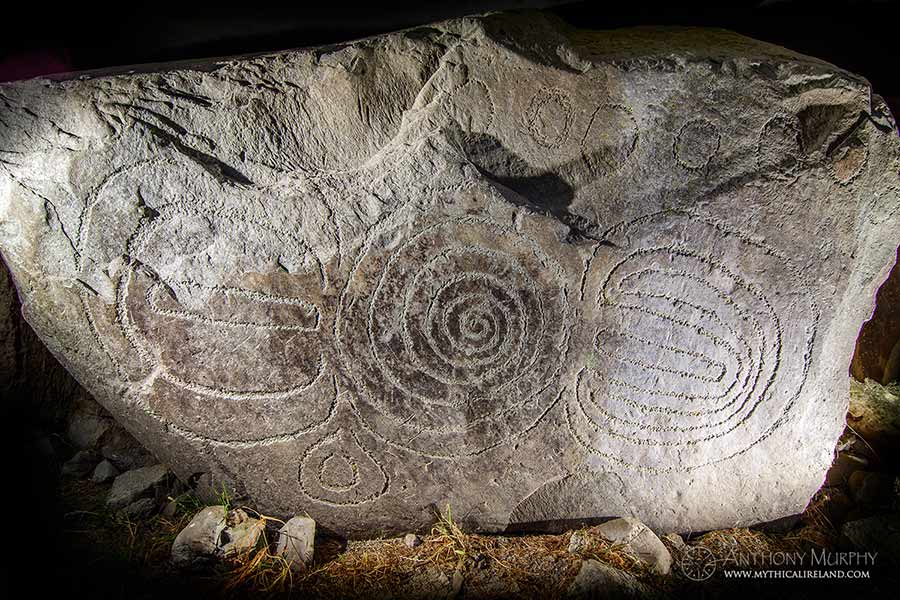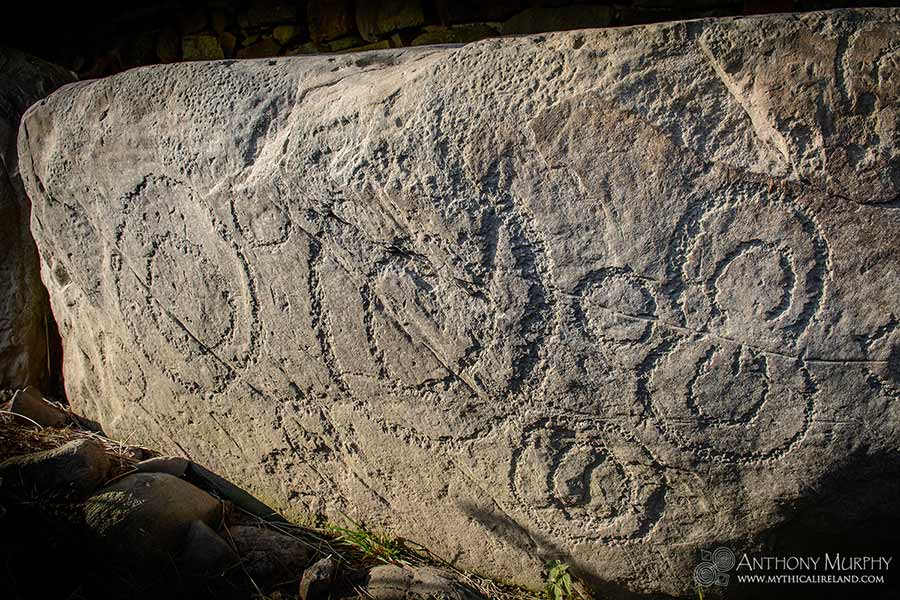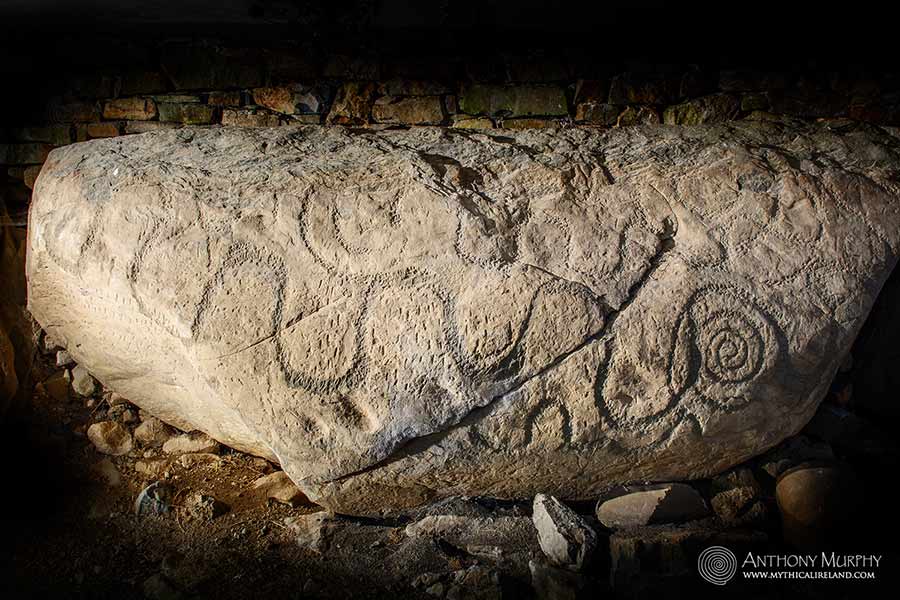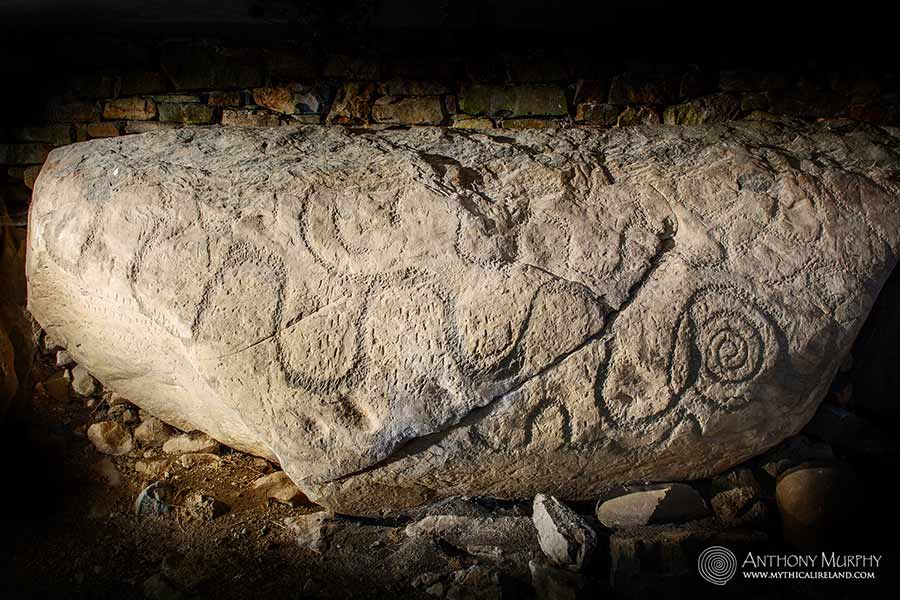Knowth contains around one-third of all known megalithic art in western Europe. There were originally 127 kerb stones. Of the 124 that survive, 90 contain lavish carvings. It is a Neolithic art gallery - a c. 5,300-year-old exploration of the arcane symbols of a mysterious culture that flourished in the Boyne Valley. Here, Anthony Murphy explores the art on many of Knowth's kerb stones.

Kerb stone 4: A large spiral is flanked by nested arcs on the left and right and, further to the right, a large series of concentric circles. On the upper part of the stone there are serpentine waved lines which may have served as counting devices.

Kerb stone 5 at Knowth is one of my favourites. The giant spiral with crescentiform motifs either side are accentuated by the darker and somewhat smooth, almost polished-like surface of the stone. Several interpretations have been suggested for this stone. One is that it represents the phases of a total solar eclipse, with the moon before crossing the sun on one side and after transit on the other. Is is, perhaps, a representation of the passages of Knowth, which face in opposite directions, approximately east and west, pointing at the sun?
What do you think it means, if anything?

Kerb stone 7 at Knowth contains a number of large double concentric circles. On other stones, these are seen to represent the fuller phases of the moon - in fact on kerb 52 there are seven, representing the week during which the moon grows from waxing gibbous phase to full moon and then into the waning gibbous phase.

Kerb stone 15: One of the most striking of all the kerb stones at Knowth, and one of the best known, this has been called the Sundial Stone. Martin Brennan in his 1980 book The Boyne Valley Vision (Dolmen) suggested that the large fanned symbol at the centre of the stone was a sundial, and that, in fact, the people who built the great monuments of Brú na Bóinne were the 'Master Diallers of the New Stone Age'. Australian engineer and author Neil L. Thomas, in his 1988 book Irish Symbols of 3500BC (Mercier Press) suggested that K15 represents a complex solar calendar, an "exact 365-day, sixteen month, four week month, five day week solar calendar". The proposition that the stone acted as a sundial appears incongruous mainly due to the position of the stone – the sundial is on a vertical face, and the plane of the surface of the stone faces towards the east. It cannot function as a practical sundial in its current position, and there is no evidence to suggest it was ever positioned with its surface horizontal. However, it does look like a sundial. In my book about Dronehenge, I made a suggestion that the main fan-like emblem on K15 looks a little bit like half a henge. Perhaps this was a guide as to how the henges should be laid out? It's unlikely, I know, and the theory is extremely tenuous to say the least, but you sometimes have to "say what you see" with megalithic art and that's as close to a convincing interpretation as you'll be likely to get.

Kerb stone 17: The largest motif on this stone is the great undulating serpentine wave across much of the front face. There are other, smaller serpentine waves too. These are not, of course, zoomorphic glyphs – there were never snakes in Ireland. Instead, they are likely to be counting devices. The spiral on the right of the large waved feature suggests a concern with solar movement.

Kerb stone 22: Another of the Knowth kerbs with its surface embellished with huge emblems. It is made of calcareous sandstone. Although there is contention about whether Irish megalithic art features anthropomorphic figures, it is tempting to see on this stone a giant, smiling face. But that would be to engage in pardeidolia. The side-be-side concentric circles, of similar or equal size, above the broad concentric arcs which cover the entire width of the front face of the stone, make an interesting and unique combination.

Kerb stone 30, Knowth: Archaeologists refer to the central motifs on this stone as "Opposed Cs", but perhaps they are crescent moons, denoting the first and last days of the lunar month.

Kerb stone 34: Interesting here is the large spiral motif which is superimposed on a number of double concentric circles. One of the features of the megalithic art of the Boyne Valley is that, in several instances, later, more embellished art is superimposed upon earlier, simpler or less refined designs. These are usually of the type defined as the "plastic" style, which according to Muiris O'Sullivan "aspires towards visual grandeur and was apparently created to enhance the architectural impact of the structure". Often the plastic art shows a disregard for the presence of previously existing elements of "standard" art. The stone is of greywacke.

Kerb stone 38: Another Knowth kerb stone upon which the spiral emblem dominates. This is another pair of interlocked summer-to-winter spirals. If you follow the spiral in the same direction as the sun's movement (i.e. from left to right or from east to west), the spirals wind inwards towards the centre. To the left is a series of zigzags delineated by a line, all contained within a crude cartouche. The zigzags appear to form triangles, such that it is difficult to ascertain what was intended by the artist - chevrons or triangles (perhaps both?). Beyond this, to the left and lower left of this group, are two small circles. Above the zigzag compound symbol, a little to the right of the large natural fissure in the stone, is a loose winter-to-summer spiral. To the right of the main interlocked-spiral emblem are a series of zigzags or chevrons. Immediately above these is a very small pair of interlocked summer-to-winter spirals – a bit like a miniature version of the main emblem. To the lower right of the main emblem, and difficult to see in this photograph, is a very small and crude summer-to-winter spiral which has been effected using much smaller pock marks than the other glyphs on the stone. It is interesting that stone 38 is on the southern perimeter of Knowth's kerb, not quite facing due south but not far off it. This stone would receive the light of the sun on every day of the year, if cloud was not an issue.

Kerb stone 51, Knowth. The huge, flourishing spiral in the centre of the stone is, in fact, two interlocked spirals. The curious split or division of the form at lower centre is interesting and mysterious. The emblem invites us to speculate about what might be represented - the coming together of cosmic bodies, perhaps; the sun and moon maybe, winding their curious paths through the sky, waxing and waning through the weeks and months.
Interestingly, Martin Brennan suggests that there are crescents emerging from the spirals, and its location immediately adjacent to kerb stone 52 (the 'Calendar Stone'), indicates a similar calendrical concern in his view.
The loosely-wound spiral to the left of the main emblem bends in the opposite direction to the main spirals, and in fact touches or joins the outer limits of this emblem. Muiris O'Sullivan says that the large design was added later, but that it respects the outline of the spiral on the left. The serpentine feature on the far right of the stone invites us to consider counting - but counting what?
The stones of Knowth are a considerable enigma. A walk around its kerb is a journey into unknown realms of the ancient human mind.

Kerb stone 56 at Knowth, where the spiral form predominates. The spiral is ubiquitous at Brú na Bóinne. I take it to represent solar movement. The winding of the spiral – inwards and outwards – can be seen as representing the expansion of the solar arc, and the contraction, between the solstices. The sun forms a low arc in winter and a much higher, larger arc in summer. The spiral might be an effort on the part of the Neolithic artists to represent the movement from winter to summer, or from summer to winter, in one continuous form. On the day this photo was taken, the sun was illuminating the panel of carvings exquisitely from an acute angle. The myths of Brú na Bóinne suggest a concern with the sun and its movements. Dagda, the chief of the Tuatha Dé Danann deities, was said to be the builder and owner of Newgrange, and the one who distributed the various other sídhe (mounds) to his fellow deities. He was also known as "deirgderc", meaning "red eye" and he controlled the weather and the harvest. As Eochaidh Ollathair, he was the horseman whose horse pulled the sun around the sky. Read more about these attributes of Dagda and his connection with the Late Neolithic monuments in my new book about Dronehenge and the other structures on the floodplain of the Boyne at Brú na Bóinne, The book is due to be released at Samhain.

Kerb stone 86: The emblems on this stone are referred to by archaeologists as "opposed Cs". This reductive term diminishes what is clearly an embellished and developed form. These are not like other Cs at Knowth, and they are not supposed to be viewed, in my opinion, as merely ornamental glyphs or decoration. The abstruse forms on many of the stones at Irish megalithic passage-tombs don't often lend themselves easily to convenient, rational or plausible interpretation. But this does not mean that we should give up too readily on the possibility that they are intended to present a vivid meaning. As an astronomer, I might see crescent moons. And I believe the moon is ubiquitous in Irish megalithic art. But no – in this stone, I see much more than that. I might see the arc of heaven. I might see the Milky Way, in all its glory, stretched in a spectacular arch across the ceiling of the night. I might see this milky road of the stars, this bright way of the heavens, reflected on earth by the Boyne river, which loops magnificently around the great monuments of Brú na Bóinne. In old times, the Milky Way was known in Irish as Bealach na Bó Finne, the Way of the White Cow. The names of the river on earth (Ábhainn Bó fhinne) and the 'river' in the sky had a similar derivation. The arches remind me of representations of the Egyptian sky goddess Nut, stretched out like the Milky Way in a giant arced form. Do these carvings on kerb 86 represent the notion of Heaven's Mirror – As Above, So Below? Is the sky reflected on the ground. Is the line in the middle representative of demarcation, the liminal boundary or space between heaven and earth? All of the symbols are enclosed in a giant cartouche, perhaps indicating the cosmos as an entity with limits – something that ends where the stars are fixed, and where the souls go after we gently place their remains into the stone chambers. Or is this stone's symbolism representative of opposed worlds (or even mingling worlds) rather than opposed Cs. Underworld, overworld. This world, the otherworld. Earth, heaven. Ground, sky. Conscious realm, unconscious realm. Reality, fantasy. Objective, subjective. Tomb, womb. So say what you C. Because if you don't, someone else will. Someone else will C what you don't C ...
(The above is a truncated version of chapter 2.3 from my book Mythical Ireland: New Light on the Ancient Past).

